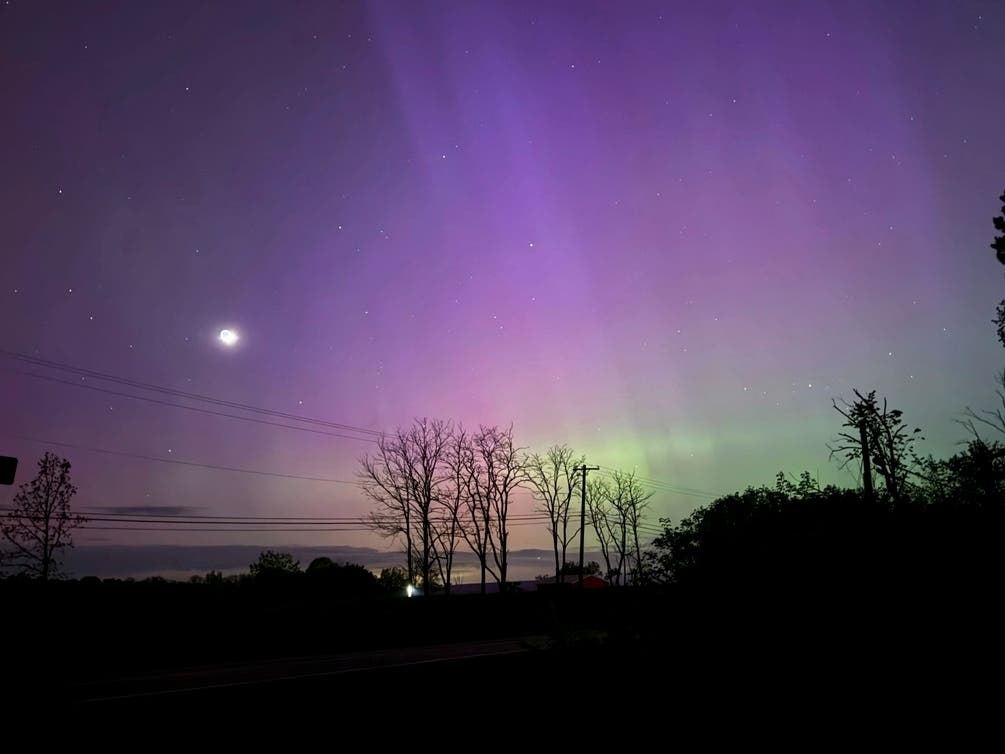Community Corner
Northern Lights Could Dip Far South This Week Due To 'Cannibal CME'
Earth-directed geomagnetic storms intensify, creating ideal conditions for aurora borealis displays in places that usually don't see them.

ACROSS AMERICA — Conditions appear favorable for Americans living from Idaho to New York see the northern lights through Wednesday after an Earth-directed solar storm created what scientists call a “cannibal CME.” The aurora borealis may be seen deep into the nation’s midsection if weather conditions allow.
The aurora forecast for Monday night and early Tuesday morning calls for a G3-level storm with a Kp Index of 7, a measure of auroral strength. The chances of seeing the northern lights are best with a Kp index of at least five.
The best chances to see northern lights are Monday night and Tuesday morning, but overnight Tuesday and Wednesday aren’t out of the question.
Find out what's happening in Across Americawith free, real-time updates from Patch.
And, space weather forecasters say, the science of predicting the timing of the arrival of auroras is still in its infancy. The timing of aurora displays may vary by 24 hours, space weather forecaster Tamitha Skov said on X.
“These are just educated estimates,” she said, noting that the region of the sun experiencing geomagnetic storming is “growing in complexity and could continue firing big flares over the next few days.”
Find out what's happening in Across Americawith free, real-time updates from Patch.
“Please take timing very lightly,” Sara Housseal, a space weather forecaster and meteorologist, said on X. “With numerous CMEs in play, it is extremely difficult (if not impossible) to determine specifics with timing.”

The Space Weather Prediction Center does its best to provide advance notification of geomagnetic storms that may cause radio or GPS blackouts, “but the forecast is not intended to be taken verbatim” for aurora borealis displays, Housseal said.
The Space Weather Prediction Center, a division of the National Oceanic and Atmospheric Administration, issued a geomagnetic storm watch through Wednesday as Earth-directed solar storms intensify.
Although not as strong as the extreme G5 geomagnetic storm in May that caused northern lights in the southern U.S. and worldwide, but still could cause the pink, purple, green and yellow auroras to dance well beyond the Arctic area around the North Pole to places like Idaho, northern Missouri and New York.
The aurora borealis — or in the Southern Hemisphere, the aurora australis, are caused by solar wind, which carries a stream of charged particles, known as coronal mass ejections, or CMEs, from the sun’s atmosphere. This natural phenomenon is typically seen in the oval area around Earth’s poles, but the ovals stretch farther south when the solar wind intensifies.
Several M-class solar flares over the weekend, combined with a merged CME, or cannibal CME, that followed prompted the watch by the Space Weather Prediction Center, which said more merged CMEs could be on the way.
The sunspot complex “is crackling with strong flares — and they’re getting stronger,” Spaceweather.com reported after an impulsive X1.5 flare. Monday morning, adding, “More X-flares are in the offing as the sunset complex turns directly toward Earth later today.”
People in and near the watch area who want to catch a glimpse of the ethereal display should keep an eye on the Space Weather Prediction Center’s aurora dashboard. Anywhere above the red line is in the viewing area. To see them, get as far away from city lights as possible. Auroras may be seen anytime after sunset, but the hours of 10 p.m. and 2 a.m.
Aurora activity is picking up as the sun enters the “solar maximum” in its 11-year cycle in which the North and South poles flip magnetic fields. More displays are likely through 2025, according to NOAA.
Get more local news delivered straight to your inbox. Sign up for free Patch newsletters and alerts.